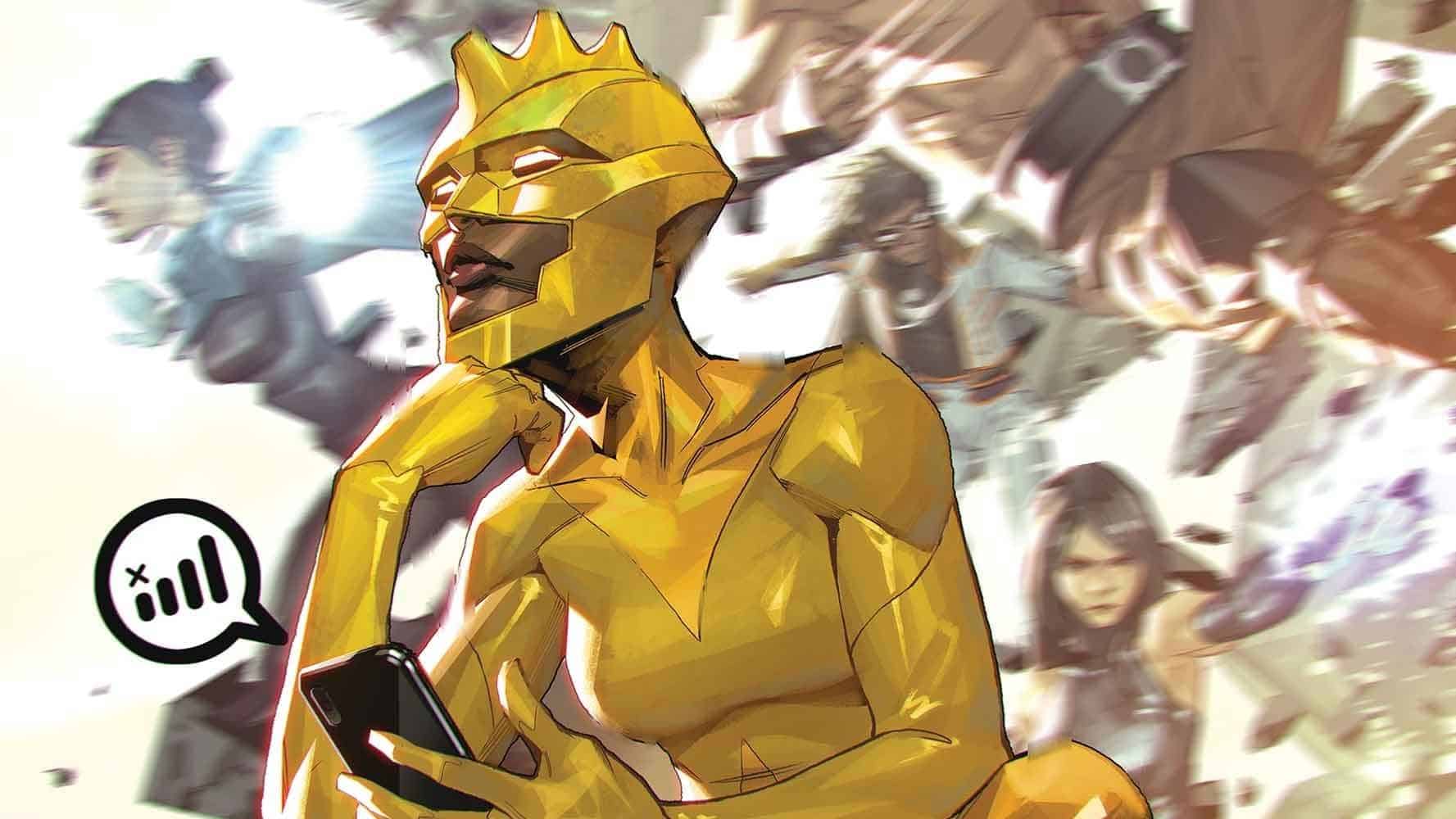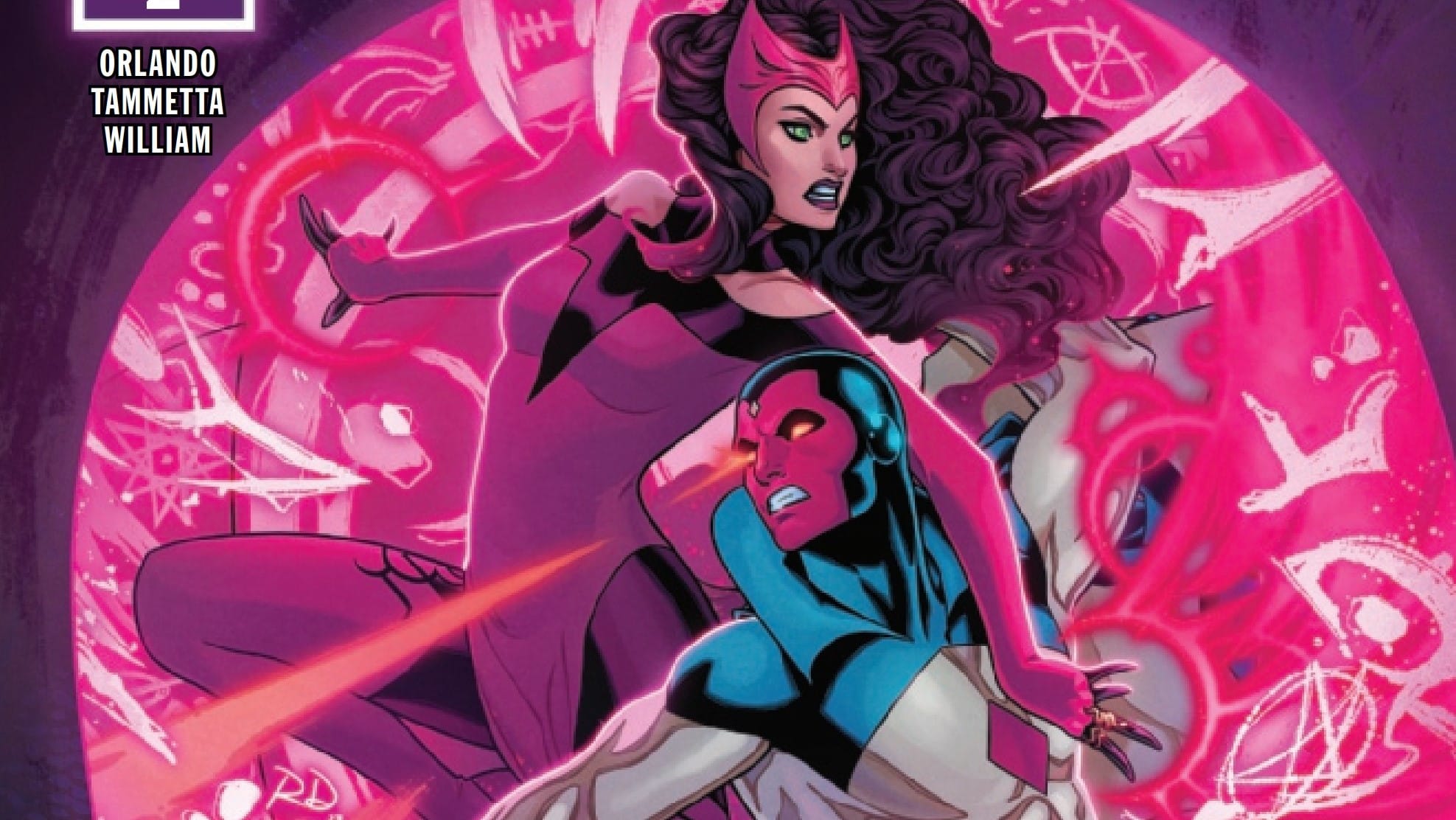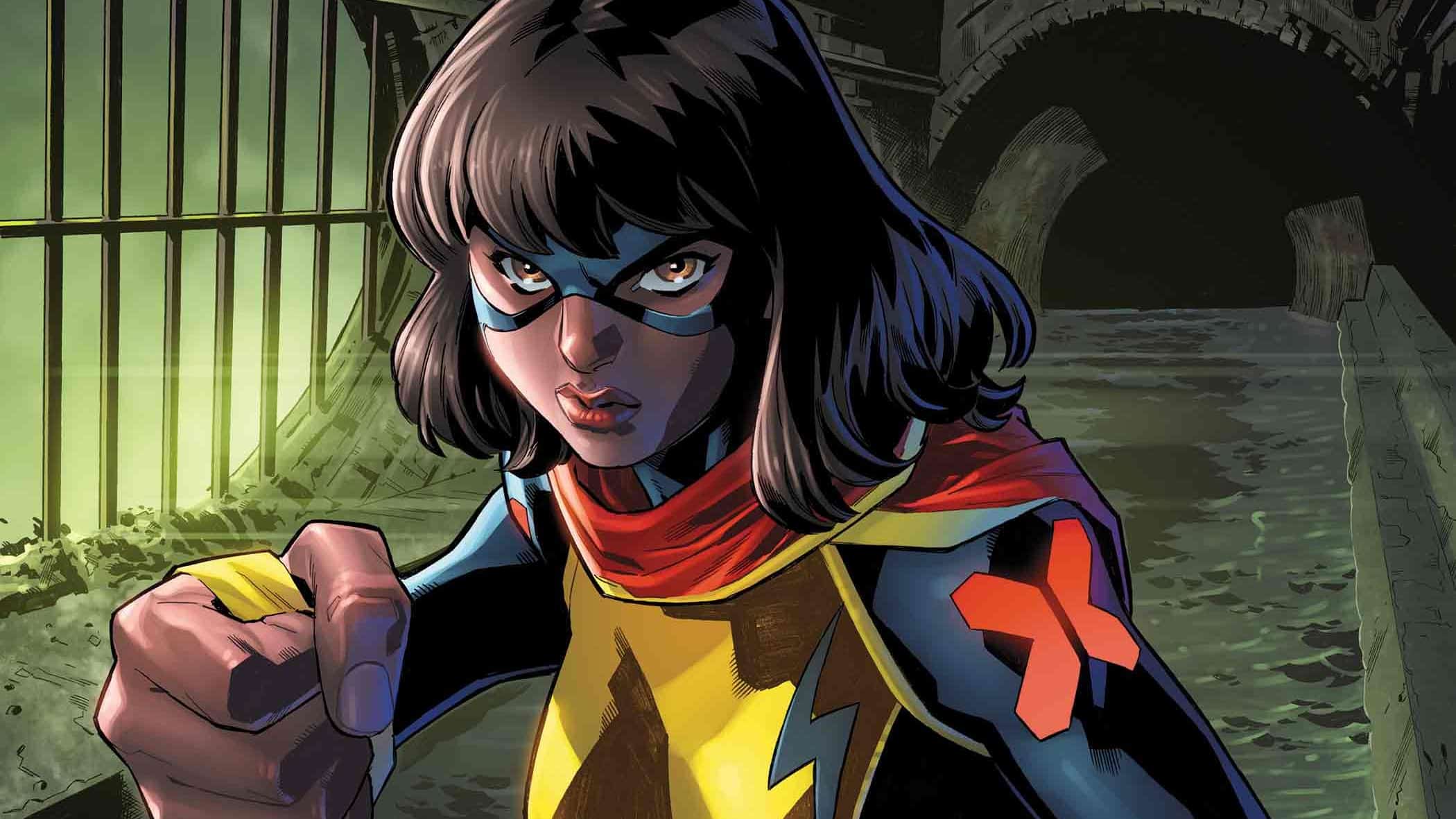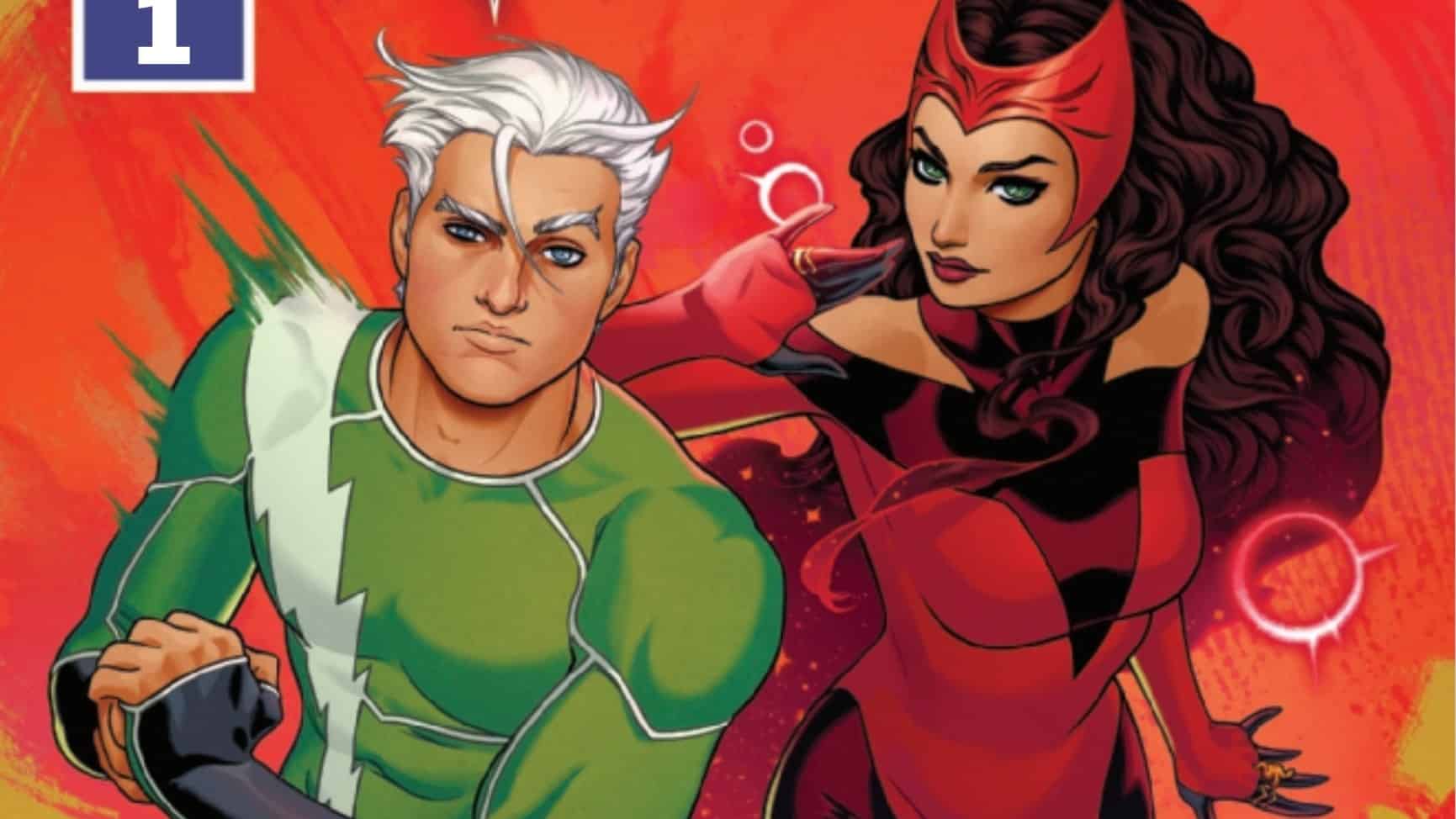What are the Kin Crimson hiding? Whose space-blood was the First Blood Shed? What’s it all about, Tempo? Find out in Marauders #4, written by Steve Orlando, drawn by Eleanora Carlini, colors by Matt Milla, letters by Ariana Maher.
Ian Gregory: Avast, Stephanie – we’re back with more Marauders! We’ve expanded beyond just the pirate thematic though, as this week the Marauders set their sights on time travel – like some sort of Time Bandits – in Marauders #4.
Stephanie Burt: My head hurts.
Bye Bye Pryde

Ian: You’ve been rather clear that the major draw for you on this book is the presence of Captain Kate Pryde. Well, I’ve got some bad news for the Shadowcat Stans in the audience: she’s dead. Again. At least this time there’s no real illusion about whether or not she’ll be back to life in a few weeks. Still, this is a definite escalation of stakes, as it appears that Xandra is completely dead as well. Last week, we were convinced there was no way Orlando would kill her off so abruptly. How wrong we were!
Stephanie: Now this is really bisexual erasure.
More seriously – though maybe not much more seriously, space opera at this scale has a hard upper limit on how serious it gets – I like the way the rest of the Marauders can’t quite tell whether they’re supposed to grieve, or get angrier while they fight, or shrug their shoulders and keep doing what they’re doing, since Kate will be back in a week or so (after these messages) unless there’s a traffic jam around Arbor Magna. I do wonder whether Kate would have been able to help solve the time dilemmas that preoccupy Marauders #4, not with her powers but with her advanced degree in physics and her knowledge of science fiction.
Anyway RIP Captain Kate for now. The rest of our crew has to get to the planet and discover the secret knowledge that the Kin Crimson have been keeping all these years, and, as Tempo says, despite her time-bending, “it still feels like we’re taking the long way.” Ian, what did you think about the substance of our crew’s adventures?
Ian: I’m still of the opinion that this book is overcrowded, but I think Orlando is doing a good job leveraging his cast. I especially like that we get some more perspective on Tempo, a criminally underdeveloped character. Using a data page to let Tempo go into more detail about her powers, and her perception of time, is perfect because uninterested readers are essentially free to skim the explanation – but X-Men time-travel heads like myself get all the extra juicy bits. Situating Tempo as the kind of temporal analogue to Nature Girl is really clever. Plus, it gives her powers way more identity than just vague “time-stuff.”
Stephanie: Tempo’s data page was one of the two things I really dug about this absolutely overcrowded, plot-stuffed, history lesson of an issue. Her relationship to time and the timestream has shaped her personality. I like her as the focal point, right now. At least until my girl Kate comes back to life. I also liked the manual typewriter font for Tempo’s exegesis. What a design choice!
Ian: Cassandra Nova also continues to surprise and delight me. She’s clearly taking great pleasure in revealing all sorts of secrets at very opportune (or inopportune) moments. I love the act she puts on of actually caring about mutantkind (“There are sacred mutants to be saved!”) With Kate dead, there’s a definite leadership struggle in this book between Bishop, Nova, and Psylocke. I hope that Orlando takes the time to explore more of how Kate holds the entire group together with her leadership and moral center.
Stephanie: Don’t hold your breath. (Or maybe do, if you’re in space.) Anyone taking directions or leadership or anything, even an ice cream cone, from Cassandra Nova at this point should know better. That’s how I felt in the first issue, and Orlando’s writing hasn’t given me any reason to change that view. The struggle to understand time – and therefore plotting, and therefore leadership and decision-making – between Lucas Bishop and Heather Tucker (Tempo)…. now that’s a struggle I want to hear and see.
Draining the Gene Pool for You

Ian: After four issues, we now know the secret of “The First Blood Spilled,” and it actually doesn’t refer to mutant blood as we, and the characters in the comic, suspected. One of the deepest and darkest secrets of the Shi’ar Empire is that their first and greatest loss came to mutants. Every subsequent loss, the Crimson Kin note, has been re-written or twisted into a Shi’ar victory. What do you think about this reveal?
Stephanie: I am of two minds. I like the idea that the great shame of the Shi’ar, a militaristic quasi-Roman culture based on imperial glory, isn’t some atrocity they committed on a defenseless population: their great shame is a military defeat. (That reveal is the other thing I super-liked.) The Shi’ar are a culture where winning is everything, and history gets written by the winners. In this case, written and then concealed in a secret book that turns out to be a guy who looks like Sabretooth with white-man dreadlocks.
Ian: I honestly thought it was Sabretooth at first.
Stephanie: I do not, however, like the idea that millions of years ago, on another planet that may or may not be Earth (or Counter-Earth? Someone call the High Evolutionary), there were mutants. It smacks of Erich von Daniken pseudoscience, finding an impossibly ancient heritage for anything we like on Earth, and it takes away the idea that mutants not only resemble, but literally are, a modern stigmatized horizontal identity that emerges, like it or not, from human populations (like being Deaf or autistic or trans). I’m OK with mutants in ancient Egypt (which surely had hearing-impaired and autistic and gender-nonconforming people too). I’m really not OK with mutants turning out to be just another space alien race that can interbreed with humans, like the Kree. We’ve already got Kree.
Ian: I think this works well with how Orlando has portrayed the Shi’ar Empire. Their greatest shame would not be something bad they’ve done, but a loss they’ve suffered. The only thing that can truly shame an Empire is its own weakness, and they have no real concerns outside of their own strength. We’ve said that an empire is always self-sustaining; that empires will do whatever possible to extend and secure their own power, even against the wishes of its ostensible rulers. I like that the First Blood Spilled is therefore about the first Shi’ar blood – because who else could the Shi’ar Empire possibly care about?
Stephanie: Exactly. And lest we compare the Shi’ar only to cultures far from ours in time and space: think about how often we, as Americans, hear about how American lives are at stake, how the United States must do all we can to safeguard American lives. Floods elsewhere? Kiribati obliterated by rising sea levels? Tropical plagues? Not our fault, till the blood they shed is American, at which point it’s a scandal. “There will no doubt be more of these such shames, and they too will be hidden to preserve the people’s pride.”
Ian: This reveal also serves to retroactively justify exactly why the Shi’ar have been so interested in mutantkind. Terrified of the resurgence of mutantkind, the Shi’ar have been monitoring them in case they pose the same threat as the pre-Arraki mutant society of Threshold. Furthermore, they’ve been systematically hunting down and exterminating “chronal refugees” from Threshold – proving that Cable and Bishop are in fact part of a long tradition of time-traveling mutants escaping global catastrophe. In fact, that last reveal is what sets off all the time travel talk. The crew of the Marauder want to go back in time to grab all the mutants from Threshold they can, before the Shi’ar blew them up.
Stephanie: Travel to the past to alter the timeline on a space-opera historical scale! Yeah, that always works out well. Ask Nate Grey.
Apocalypse Accepted

Ian: I’m certainly interested in Threshold, the first mutant society, but I do wonder if we’ve had a few too many “first mutant societies” lately. We’ve got Okkara, Arrako, and poor Namor used to be called “the first mutant!” Threshold has a kind of ancient Greek vibe to it. While I liked all the myriad mutated character designs, I’m just a little tired of “ancient and forgotten mutant societies.” I also think the name, Threshold, lacks some of that exciting historical gravitas that we got with the Otherworld mutants.
Stephanie: Thanks. I hate it. The word “mutant” has been drained of its implications. It’s like being Kree. Or Inhuman (a gene pool from space that predates Homo sapiens, but reemerges every so often among baseline humans, who don’t understand why). Threshold looks great – Carlini excels whenever she doesn’t have to draw close-up faces! – but I don’t think it belongs in an X-book. Ian, does this version of Marauders even feel like an X-book to you? Or could it just as well be a story about Hawkman and Thanagar with the names changed? (Not a random reference: the old-school Shi’ar look a lot like Thanagarians.)
Ian: Good question, and I’m not sure I have a great answer. It’s hard to say what makes this so different from those Claremont space issues with the Starjammers and the Brood – but then I feel like you might be able to argue that those comics aren’t superhero comics either.
Stephanie: Those comics are some of Claremont’s best! Claremont’s mutants from Earth are still mutants from Earth – still Earthlings – in space, even if they find they’ve wandered into a Ridley Scott horror film, or into – wait for it – space pirate adventures. Sure, there are cosmic stakes in the Brood Saga, but there are also personal ones linked to mutants’ backgrounds: Wolverine’s healing factor interacts with the Brood life cycle, Storm is uniquely qualified to be a space whale, and Chris (note the name) is Scott’s dad. The Threshold mutants aren’t linked to specific characters we know and love. Or not yet.
When I make a list of what distinguishes mutant comics from other superhero comics – and yes, I tried to make such a list, I’m like that – I find that almost none of the things on that list occur in Orlando’s Marauders. Except the recurrence of decades-old minor-ish characters. That part I dig. And maybe I’ve just become the worst kind of Old Fan: the one who wants more of what she liked years ago. Don’t listen to me, Steve Orlando. Tell your own new stories. About hawks.
Ian: We get our first preview of what’s to come in the last two pages, when the Marauders emerge on Avalon in the 1990s – or was Avalon just a few years ago for them? The sliding time-scale is confusing. In any case, it seems we’re set up for a huge time-travel romp next issue, starting with “The Age of Nemesis,” the blessedly renamed son of Apocalypse.
Stephanie: Romp? I dunno about romp. Definitely a lot of time-travel though. “A space-and-time heist.” I look forward to Tempo explaining it all. I very much like Tempo as the voice of reason and the voice of the reader. The more of her I see the more I believe that there will be hard stakes for this book, which have now become… whether we can stop some combination of Bishop and bad guys from changing the past? “Preserving the future’s much harder. And riskier,” Tempo explains. Sometimes we don’t know how good we have it, or how fragile our frustrating and rickety existing institutions are, or how much worse things could get.
Ian, do you think Bishop has a pattern of rushing into the past to perform ill-considered acts of violence that he wrongly believes will save the world? Or is it just me? Also, is that pattern what makes this book an X-book?
Ian: I would definitely argue that a propensity to abuse time travel to solve your problems is definitely a dominant X-trait, and Bishop has it in spades. I did like when they made Bishop more of an actual “time cop” for about three issues back in 2018 or so, where he used his “time computer” to detect and avert apocalyptic events. Guy’s a meddler, and while that’s definitely a positive trait at times, it leads to an interesting conflict with Tempo. I do like that Orlando is returning, at last, to the idea of “mutant rescue,” the Marauders’ mission statement. Here, they’re trying to save mutants traveling through time from Shi’ar assassination, plucking them from the time stream instants before they would die. It’s pretty clever, but I wonder if that conceit is a little too deeply buried.
Stephanie: Once you accept that there’s an entire ancient pre-human planet of, uh, mutants (what does that even mean? That they have the X-gene?), the rest follows.
Ian: On another note, I would say we’ve been fairly critical of Carlini’s art on this series, but I have to wonder if she’s not just being mismanaged. We get a few brief scenes of Deathbird on Chandilar, and of Threshold, that make me think Carlini does exceptionally well with huge city scenes and crowds, of which we’ve had fairly little – the Marauders have mostly been in tight spaceships and gray hallways. The expressions are as cartoony as ever, but I’m definitely still enamored of the fight scenes and the various power effects. I suspect that, given different locales to work with, we might enjoy Carlini’s art much more.
Stephanie: I love these locales! I have no problem with the locales this time out. You and I have the same take here. I would like to see Carlini draw, uh, Hawkman! And the Guardians of the Galaxy! And the Nine Realms! Give her cities, space battles, and galaxies, and people fighting in spacesuits with space lasers! And then when the helmets come off, have someone else draw heads.
Speaking of people with heads, check out the dome-headed and no-neck armor on Nemesis, the son of Apocalypse from the Age of Apocalypse timeline. He’s going to fight Cassandra Nova. What could go wrong? Are we going to get an entire alternate reality like the Ages of Apocalypse, of X, and of X-Man? Will it take place right now, or in the equivalent of the 1990s, or what? I’m betting whatever it is, it’s confined to this book, or we would have seen a pitch for a crossover event by now. I hope our Marauders get back to the main reality in time for the Hellfire Gala. Except Cassandra Nova. She can stay.
Ian: It does feel a bit like we’re diverting into Exiles territory, doesn’t it?
Stephanie: I’d love to see this book look more like Exiles, with alternate versions of characters we know and love. Or hate. (That would be Exiles, the 100-issue run written by Winick, Bedard, and Claremont, not the upcoming Sabretooth and the Exiles.) Ian, do you have an overall take on the book’s direction? I wanted more character work and lower stakes, and our pirates sailed in the opposite direction. I’ll stay with it, but I’m with Tempo: I have a bad feeling about all this.
Ian: Funnily enough, I think this book has grown on me the more ambitious it’s gotten. I’m glad that if we’re going off to space to do some Big Darn Adventure Stuff we’re at least doing something fairly novel with X-Men history. I think Orlando is working with some fairly clever ideas, but I also think they’ve gotten buried behind all the action and set dressing. I wonder if, had we two or three fewer fights and a little more time to chew on these characters and concepts, we both might have enjoyed this book more.
SPACE PIRATE BOOTY
- “I know the look. Saw it plenty in the Mutant Liberation Front. You want to go back in time,” got a real laugh out of me. We know, Tempo. Stryfe sucks.
- “The closer to your “now” you go, the more dangerous the trip is” – also advice about writing science fiction. Trust Tempo, people. Always trust Tempo.
- The Thresholders had exactly five heroes. What are the odds our Marauders rescue all five?







